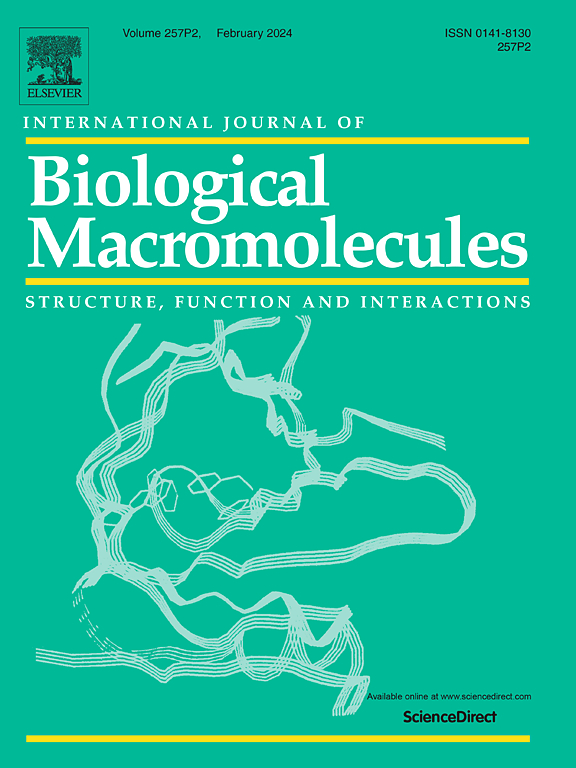两亲性 pH 响应核壳纳米粒子可提高纤维素类给药系统的性能。
IF 7.7
1区 化学
Q1 BIOCHEMISTRY & MOLECULAR BIOLOGY
International Journal of Biological Macromolecules
Pub Date : 2024-12-01
DOI:10.1016/j.ijbiomac.2024.137659
引用次数: 0
摘要
聚合物和纳米粒子(NPs)能够共同形成纳米复合材料,结合传统单一体系的有益特性。在这项工作中,我们提出了一种刺激响应型纳米复合材料体系,它将 pH 响应型 NPs 与纤维素结合在一起。通过开环聚合(ROP)和两个可逆加成-碎片链转移(RAFT)聚合步骤合成了((PHEMA-接枝-LA12)-co-PMAA)-b-PDEGMA 共聚物,该共聚物具有定制分子量和低分散值的特点。通过在水中对所获得的共聚物进行纳米沉淀,可获得均匀的 NPs。此外,在不同 pH 值下的药物释放研究(使用罗丹明 b、异硫氰酸荧光素、芘和 5-氟尿嘧啶)证明了 NPs 的 pH 响应性,表明在酸性条件下疏水分子的释放得到显著改善。体外测试验证了 NPs 的生物相容性和降低癌细胞活力的功效。最后,将 NPs 装入羟丙基甲基纤维素-C12 基质中,得到最终的聚合物-NPs 复合系统。复合系统显示,NPs 负载的低立体阻碍药物和聚合物网络中负载的高立体阻碍药物都能持续释放。总之,所提出的 pH 值响应型给药系统是一种联合给药装置,可用于不同联合治疗方案中的局部治疗。本文章由计算机程序翻译,如有差异,请以英文原文为准。
Amphiphilic pH-responsive core-shell nanoparticles can increase the performances of cellulose-based drug delivery systems
Polymer and nanoparticles (NPs) together are able to form nanocomposite materials that combine the beneficial properties of the traditional single systems. In this work, we propose a stimuli-responsive nanocomposite system which combines pH-responsive NPs with cellulose. Ring opening polymerization (ROP) followed by two reversible addition-fragmentation chain transfer (RAFT) polymerization steps were performed to synthetize ((PHEMA-graft-LA12)-co-PMAA)-b-PDEGMA copolymer characterized by tailored molecular weights and low polydispersity values. Uniform NPs were obtained by nanoprecipitation of the so-obtained copolymer in water. Moreover, drug release studies (using rhodamine b, fluorescein isothiocyanate, pyrene and 5-fluorouracil) at different pHs demonstrated the pH-responsivity of NPs, revealing a significant improvement of hydrophobic molecules release at acidic conditions. In vitro tests verified the biocompatibility of NPs and the efficacy in decreasing cancer cell viability. Finally, NPs were loaded into hydroxypropylmethyl-cellulose-C12 matrix to obtain the final polymer-NPs composite system. The composite systems showed the ability to sustain the release of low steric hindrance drugs loaded with NPs and high steric hindrance ones loaded within the polymeric network. Overall, the proposed pH-responsive drug delivery system represents a co-delivery device which could be applied for localized treatment in different combined therapeutic program.
求助全文
通过发布文献求助,成功后即可免费获取论文全文。
去求助
来源期刊
CiteScore
13.70
自引率
9.80%
发文量
2728
审稿时长
64 days
期刊介绍:
The International Journal of Biological Macromolecules is a well-established international journal dedicated to research on the chemical and biological aspects of natural macromolecules. Focusing on proteins, macromolecular carbohydrates, glycoproteins, proteoglycans, lignins, biological poly-acids, and nucleic acids, the journal presents the latest findings in molecular structure, properties, biological activities, interactions, modifications, and functional properties. Papers must offer new and novel insights, encompassing related model systems, structural conformational studies, theoretical developments, and analytical techniques. Each paper is required to primarily focus on at least one named biological macromolecule, reflected in the title, abstract, and text.

 求助内容:
求助内容: 应助结果提醒方式:
应助结果提醒方式:


